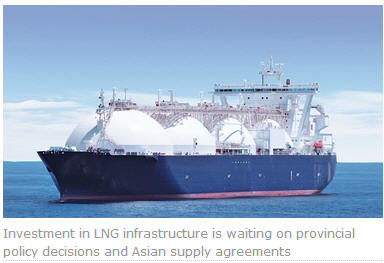LNG projects could generate $200 billion in investment in BC, EY estimates
U.S. and Australia have a head-start in the global race to dominate market, LNG conference speakers warn
By 2020, the British Columbia government hopes to see three major liquefied natural gas plants on the West coast of B.C. – something professional services firm EY estimates would generate more than $200 billion in investment.
That’s when many 20-year LNG contracts with large customers in Asia – primarily electrical utilities – are up for renewal.
But it will take four or five years to build the pipelines and LNG plants, and to date, none of the pipelines that will be needed to supply the LNG plants are under construction.
No offtake agreements with Asian customers have been signed yet, no final investment decisions have been made, and the industry is still waiting for details on the implementation of a new two-tiered LNG tax.
Meanwhile, Australia has three LNG plants already in operation, seven under construction, and a new Exxon Mobil LNG plant in Papua New Guinea loaded its first tanker – destined for Japan – just last week.
The U.S. is also now a potential competitor and has a head start on B.C., which is starting from scratch.
“The U.S. projects are starting on second base,” said Edward Kelly, vice-president of natural gas for the energy consulting firm IHS CERA. Kelly is among the speakers on a panel focusing on global competitiveness at this week’s annual LNG Conference sponsored by the B.C. government.
“They’ve got the harbour, they’ve got the tanks there, they have natural gas infrastructure in place, [and] they’re offering a clear model for North American gas price exposure.”
B.C. Finance Minister Mike de Jong acknowledges the urgency. “There’s a race and the stadium for this race is the world,” he said.
Despite the time pressure, de Jong is not rushing to implement B.C.’s new LNG tax. The two-tiered tax was announced in February, but it won’t be finalized until the fall. It would start at 1.5% on net profits and rise to a maximum of 7%, after the initial capital investments are paid for.
Jack Mintz, Palmer chair of the University of Calgary’s School of Public Policy, has criticized the tax.
“It will create a disincentive for investment,” he told Business in Vancouver.
The tax sets a precedent, he said, by taxing income on LNG processing, rather than being set as a royalty on gas at the wellhead, which is typically how provincial governments tax oil and gas.
De Jong dismisses Mintz’s criticisms, saying the industry itself does not seem to have a major problem with his government’s LNG tax.
“I don’t think you’ve heard much in the way of argument from the proponents themselves about this representing a reasonable mechanism,” de Jong said.
Of the 14 LNG projects proposed, eight have received export licences. Pacific Northwest LNG – an $11 billion LNG plant proposed for Prince Rupert by Malaysia’s Petronas – and the Shell-led LNG Canada project in Kitimat – are considered frontrunners of the larger scale proposals.
Should B.C. miss the boat on near-term contracts in Korea and Japan, there are always longer-term markets B.C. LNG producers can go after.
“China is clearly a longer-term market, with even greater potential than the two countries [Japan and Korea] put together, simply because of the size of China,” said Asia Pacific Foundation CEO Yuen Pau Woo, who will be moderating a panel on export markets at the LNG conference, which runs from May 21 to 23.
Kelly describes the global market for LNG as a kind of expanding “universe” where both the demand and competition will grow over time.
“As we go further out in time, the universe widens, and the range of opportunity widens,” he said. “If you are competing for the mid-2020s, instead of late teens or early 2020s, then the contestable market may, in fact, expand a great deal in size. So both the opportunities and the potential competitors expand.”
As China switches from burning coal to natural gas for power generation, the potential market for both natural gas and LNG there is expected to become enormous.
But there are uncertainties that could affect that demand, including China’s own ability to develop a domestic shale gas and coal bed methane industry, as well as the potential to increase its supplies of pipeline gas from Russia, Central Asia and Myanmar, according to a recent study by the Oxford Institute for Energy Studies,
Should three major LNG projects get built, it will result in $190 billion to $280 billion investment in B.C., said Barry Munro, EY’s Canadian oil and gas leader, who will be speaking on a panel on B.C.’s advantages at this week’s conference.
Based on three major LNG projects, Munro said EY calculates the upstream investment alone (natural gas drilling) would be $140 to $200 billion.
Three LNG terminals would cost $30 to $50 billion, and two pipelines would cost $10 to $15 billion. Another $10 to $15 billion would be spent on midstream infrastructure, including gathering systems and processing plants.
{{ commodity.name }}
{{ post.title }}
{{ post.date }}


Comments